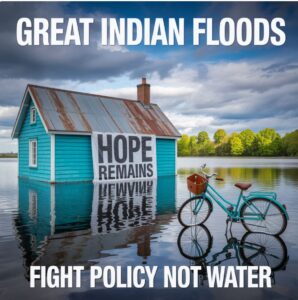A systematic analysis of 308% groundwater exploitation and the 18 month countdown to municipal collapse

Gurugram extracts groundwater at 308% of sustainable levels while water tables plummet 15 meters in nine years. With 18 months before “Day Zero,” India’s corporate capital faces collapse unless developers act decisively. The mathematics are brutal; has the countdown begun ?.
Gurugram’s ₹2.5 trillion transformation from agricultural farmland to India’s corporate capital represents one of modern India’s most dramatic urban metamorphoses, yet this gleaming facade of glass towers and luxury developments conceals a water crisis that threatens to unravel three decades of unprecedented growth. Municipal data reveals a catastrophic 308% exploitation of sustainable groundwater resources, compounded by an engineered paradox where the city’s arid Rajasthani climate leaves it parched while neighboring Delhi and Noida flourish with river-fed rainfall. Urban sprawl has systematically demolished the city’s protective dam infrastructure, creating a vulnerable concrete landscape where residents face dual threats of water scarcity and catastrophic flooding during intense downpours, with no viable drainage systems.
The Mathematics of Depletion
The numbers paint an unambiguous picture of resource mismanagement. According to TERI and GMDA assessments, Gurugram extracts groundwater at three times the rate of natural recharge, with water table levels dropping 2-5 meters annually across monitored zones. This translates to a catastrophic deepening from 18.7 meters in 2005 to 34.35 meters by 2014,an 83% decline that has only accelerated as development intensified.
The infrastructure supporting this exploitation tells its own story. It is widely believed and ‘unofficially’ documented that over 30,000 illegal borewells operate across the city, with the majority serving construction and development projects. These extraction points, largely unmonitored and unregulated, have created what hydrologists term a “dark zone” an aquifer system beyond sustainable recovery without immediate intervention.
The supply-demand equation reveals the crisis in stark relief. Summer 2025 demand peaked at 675 Million Liters Daily (MLD) against available municipal supply of 570-630 MLD, forcing the city into emergency tanker deployment protocols. With demand projected to reach 1,650 MLD by 2031 while supply capacity remains essentially static, Gurugram faces a mathematical certainty of systemic failure.
Ecological Infrastructure Collapse
Gurugram’s water crisis stems not merely from over-extraction but from the systematic destruction of natural water management systems. Satellite analysis reveals the disappearance of 137 water bodies since rapid development began, while wetlands have shrunk by 99.2%,from 55.2 square kilometers in 2007 to just 0.42 square kilometers in 2025.
This ecological vandalism has profound hydrological consequences. Natural water bodies serve as recharge points for groundwater systems, while wetlands act as filtration and storage mechanisms during monsoon periods. Their elimination forces precipitation into concrete drainage systems, converting what should be groundwater recharge into surface runoff that ultimately reaches the sea without benefiting local aquifers.
The concretization of previously permeable agricultural land compounds this effect. Where soil once absorbed rainfall and channeled it to underground reserves, impermeable surfaces now direct water away from the very systems that sustained the region for centuries.
Regulatory Failure and Implementation Gaps
The gap between policy intention and ground reality exposes fundamental governance failures. Gurugram’s 627 registered rainwater harvesting pits should represent a cornerstone of sustainable water management. However, municipal audits reveal that 60% are non-functional, with operational units capturing less than 15% of their design capacity.
Wastewater management presents an even more damaging picture. Of the city’s 699.4 MLD daily wastewater generation, only 30% receives treatment before discharge. The remaining 489.58 MLD flows untreated into drainage systems, contaminating what limited groundwater recharge occurs naturally.
GMDA’s “Zero Water Footprint” mandate, requiring dual-piping systems and imposing ₹10,000 daily fines for non-compliant sewage treatment plants, represents belated recognition of the crisis. Yet implementation remains inconsistent, with compliance heavily skewed toward premium developments while affordable housing and peripheral villages continue to operate without basic water security infrastructure.
Economic and Social Stratification
The water crisis has created a two-tiered system that mirrors Gurugram’s broader economic disparities. High-end residential societies spend ₹3-4 lakh monthly on tanker water, while implementing closed-loop systems that reduce consumption by 40%. These developments often feature functional sewage treatment plants and dual-piping networks that meet regulatory requirements.
Conversely, mass housing projects and villages like Badsa depend on contaminated tanker sources and utilize untreated wastewater for irrigation. Property markets reflect this disparity, with water-scarce sectors experiencing 15-20% devaluation as buyers increasingly prioritize water security over traditional location premiums.
The emergence of what residents’ term “tanker mafias” adds a criminal dimension to the crisis. Documented cases in Sector 102 reveal systematic pipeline sabotage, allegedly by groups controlling emergency water supply, forcing residents into dependency relationships that cost lakhs annually.
Technology Solutions and Scalable Models
Despite the crisis, emerging solutions demonstrate the potential for systematic recovery. GuruJal’s pond rejuvenation program has restored 33 water bodies with 120 more planned, while Badsa’s innovative “waste water johads” convert sewage into groundwater recharge systems.
Municipal Corporation Gurugram’s street-level harvesting captures 72,000 Liters daily, demonstrating how urban infrastructure can be redesigned for water conservation. GMDA’s network of 134 piezometers enables AI-driven shortage prediction, allowing for proactive rather than reactive management.
The technology exists for comprehensive solutions. Closed-loop systems achieve 40% consumption reduction with zero liquid discharge, while dual-piping networks can cut municipal demand by 30%. However, implementation requires coordinated action across private developers, municipal authorities, and regulatory bodies.
The 18-Month Imperative
Deputy Commissioner Amit Khatri’s warning carries mathematical precision: with current depletion rates and projected demand growth, Gurugram has approximately 18 months before reaching “Day Zero”, the point where municipal water systems can no longer meet basic residential and commercial needs.
This timeline demands immediate implementation of comprehensive water management strategies. The revival of 250 water bodies, mandatory 100% wastewater recycling for developments exceeding 5 acres, and enforcement of Aravalli protection zones represent minimum intervention requirements.
Private developers, as the primary architects of Gurugram’s transformation, bear proportional responsibility for its salvation. Their projects generated the demand that depleted aquifers while destroying natural recharge systems. Corporate social responsibility demands they lead recovery efforts through technological innovation, regulatory compliance, and equitable resource access.
Legacy or Catastrophe
Gurugram’s water crisis represents a case study in unsustainable urbanization, where economic success generated the conditions for its own potential collapse. The 308% exploitation rate and 18-month timeline to crisis point leave no room for incremental solutions or delayed implementation.
Engineered paradox needs an engineered solution
The city’s survival depends on recognizing water security as fundamental infrastructure, not an afterthought to development planning. Developers must integrate watershed management into project design, mandate comprehensive wastewater recycling, and ensure equitable access across all housing segments. ‘The strategic solution requires constructing artificial lake ecosystems modelled after successful urban water bodies like Hyderabad’s Hussain Sagar and Ahmedabad’s Kankaria Lake, integrated with Haryana’s existing river network and comprehensive stormwater management systems to engineer a water-resilient metropolitan framework capable of sustaining continued economic growth.’ – one among many solutions advocated by citizen Group’s and residents like Rachna Verma.
Gurugram’s next chapter will be determined by whether it can transform its relationship with water resources as dramatically as it once transformed its economy. The mathematics are clear, the technology exists, and the timeline is defined. What remains is the political will to implement solutions before mathematics becomes catastrophe
Read . Trust . Share


